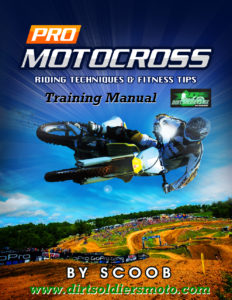Types of Aerobic Activities and Moto-Workouts
Outdoor Activities
Bicycling
Bicycle riding, or biking, is an excellent activity for improving overall cardiorespiratory fitness for moto. Importantly, indoor bicycle ergometers have been used for many years to study the responses of the body to exercise. The work rate you maintain while biking varies according to the terrain and your motivation. As such, biking outside offers many challenges.
It is also a very efficient means of locomotion: the energy cost of biking is only 20% of walking, but you can travel almost five times faster on a bicycle. The quadriceps muscle in the front part of the thigh is the primary muscle for high rates of power output, and seat height can markedly affect overall muscle involvement. Although pedaling rates vary from 40 to 100 RPM, a rate of 70 appears to be the most comfortable
A high pedaling rate offers advantages in terms of a high power output.
All in all, biking is a great alternative to running, and should be considered as a suitable activity for maintaining fitness. Biking complements other activities and is often used in rehabilitation from other musculoskeletal injuries.
Cross-Country Skiing
This is an excellent method of training for cardiorespiratory fitness. It engages almost all of the major muscle groups and thus, the overall energy expenditure may be as high or higher than when moving the body over the same distance on foot. Importantly, the intensity of the effort varies greatly as a function of the terrain: climbing uphill requires tremendous effort whereas going downhill represents a light load. High caliber cross-country skiers have some of the highest maximal oxygen uptakes ever recorded However, the appropriate equipment and environment are necessary for cross-country skiing.
Jumping Rope
Jumping rope is a great way to maintain fitness while traveling or in confined spaces. It can provide a high intensity, cardiorespiratory workout if done long enough and fast enough. If the pace is fast, it is equivalent to running in terms of energy expenditure. Jumping rope does not have to be boring, especially if you use different types of jumps. Table 3-6 provides the names and an explanation for alternatives to the basic jump.
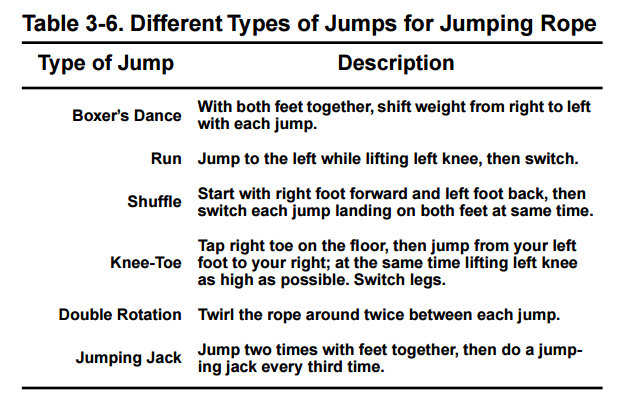
In terms of gear, many different types of rope are available, and rope jumping can be limited by the quality of the rope. Most experts recommend lightweight leather ropes. Believe it or not, many books have been written about jumping rope, with basic to advanced skills, drills and moves. Overall, jumping rope is a great activity, especially if you are in a confined environment.
Stationary Exercise Alternatives
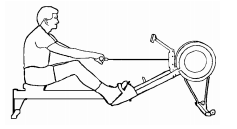
Rowing Ergometer There are many types of rowing machines on the market, and each has distinct advantages and disadvantages. The best rowing machine is one with variable resistance and the ability to regulate rowing rate. Most provide feedback on either watts or kcalories per hour, as well as meters covered. Proper technique is critical so as not harm your lower back. If proper technique is maintained, cardiorespiratory conditioning can easily be achieved. In fact, both the upper and lower body are exercised, and it promotes flexibility by emphasizing maximum joint range of motion, so it is a total body workout. It is also impact free so it is a great alternative to running! Some key points to remember are:
- The motion of the entire stroke should be fluid.
- A stroke rate between 24 and 30 per minute should be the goal.
- Your grip should be loose and comfortable with wrists level.
- The rule of thumb should be a longer not a harder workout.
Just plain rowing can become a bit boring, but there are many ways to make it fun and varied. Table 3-7 presents descriptions of various workouts for a rowing ergometer.

How do you know if the workout is hard or light? Your body is the best judge, but knowing the kcal/hr will also help. A pace of 500 meters/4 minutes would be a light workout whereas a pace of 500/2 minutes would be strenuous. These paces equate to 385 and 970 kcal/hour for a 70 kg man.
Bicycle Ergometers
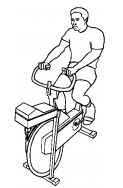
Cycle ergometers have been around a long time, and are still the mainstay in exercise/fitness testing. Monitors on the bicycles available today typically display kcal per hour. Table 3-8 presents kcal/hour values for stationary bicycle workouts at various intensities. These values can be used to gauge your work rate during indoor biking.
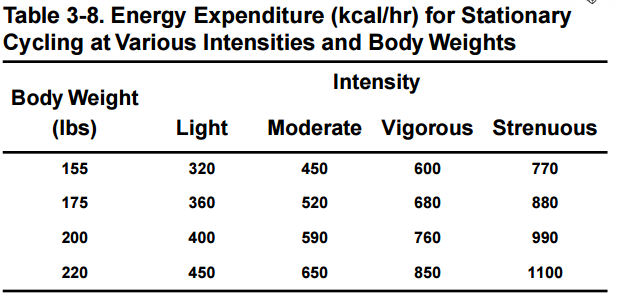
Treadmills
Despite the fact that it is much nicer to run outside than inside, the treadmill is an extremely efficient way to maintain and/or improve cardiorespiratory conditioning. Unlike the cycle and rowing ergometer, jogging or running on a treadmill is weight dependent: the energy expended is determined by your body weight. In addition, it is an impact sport and should not be the only form of conditioning, so joints are protected and injuries minimized. However, if you in a motel or in another type of confined space, a treadmill could maintain your fitness! What kind of workouts should you do on a treadmill? Three days per week is more than enough, if you do other types of exercise on off days. On a treadmill, you can mix up your pace and/or change the resistance by changing the incline. The incline and speed will determine the intensity of the workout. Remember, a strenuous workout is over 750 kcal/ hr, and a moderate workout would be 450 to 600 kcal/hr. Table 3-9 presents kcal/hr values for treadmill workouts. These values can be used to determine the speeds and grades for indoor running.
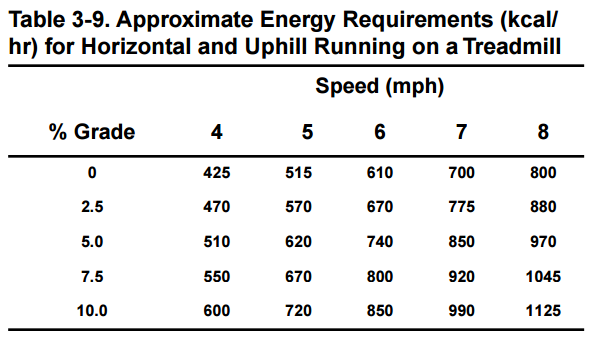
Ski Machines
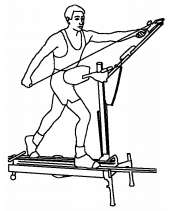
The simulated skiing machine provides an excellent mode of exercise for whole body conditioning. It uses both the upper and lower body, and offers a range of settings so your workout can be light, moderate, vigorous or exhausting.
Maintaining a comfortable rhythm is most important during a moderate workout, and is essential for progressing to a strenuous workout. Importantly, unlike running outside or on a treadmill, minimal stress is placed on the joints.
Most models have various settings for modulating leg resistance, and typically the resistance ranges from four to 32 lbs. Once you have determined your desired resistance the intensity of your workout will be determined by your average speed.
Numerous tables are available which allow you to determine the number of calories expended per minute at various resistance settings and speeds. However, they are far too detailed to include here. Table 3-10 presents the kcal/hr expenditures for various settings and speeds for a 70 kg (155 lb) man. These values can be used as to estimate your actual work rate.
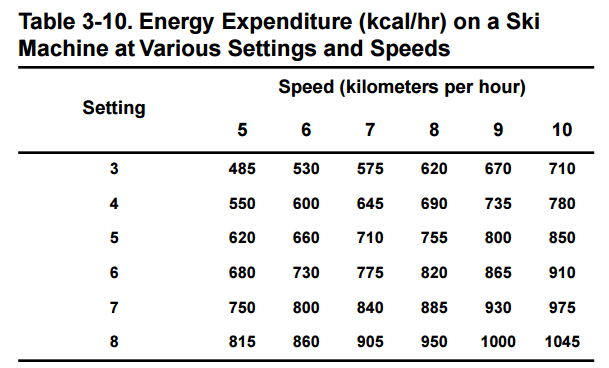
Stair Steppers
Stair steppers provide an excellent alternative to running, biking, and other forms of aerobic exercise. Although stair-stepping is a weight-bearing exercise, the impact is much less than with running. However, to get the full effect, instructions must be followed. Most people hang on to the handles and this diminishes the conditioning effect. An equally good workout could be gained by actually climbing real stairs for the same period of time; many people climb stairs without holding the handles, and thus carry their full weight up the steps. By hanging on, you allow your arms to support a portion of your body weight and the energy demands are less.
Most stair steppers have a variety of computerized, pre-designed programs to meet the needs of devoted users. There are interval training programs, climbing programs, manual programs, and many other creative exercise programs to vary the intensity of the exercise.
Although each manufacturer has its own energy cost equations, the wayto determine work intensity is to determine the number of steps per minute; one step is typically 8 inches of vertical climb.
A low intensity exercise would be a step rate of less than 35 steps/minute, whereas a high intensity workout would require a step rate in excess of 95. This is not an easy exercise routine. Table 3-11 presents the approximate energy expenditure in kcal/hr for a 155 lb Motocross Racer at various stepping rates.
Climbers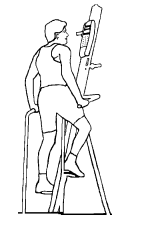
Workouts on a climber will build upper body strength and provide excellent cardiovascular conditioning. Different types of climbers are available, and each has specific characteristics. Regardless of which variety isused, climbers have common features: weight dependent exercise that conditions primarily the upper body.
Energy expenditure on a climber depends on your speed of climbing and your body weight. Some authorities would say that climbing results in a greater energy expenditure than most other activities, but this depends on your strength and how hard you work. Table 3-12 provides kcal/hr at selected weights and ascent rates.

The most important issue with respect to workouts is recovery. Rest is an exceedingly important factor in recovery from strenuous workouts, so back-to-back high intensity workouts are not encouraged. Experts recommend a hard day followed by an easy day, and at least one day of rest over a seven day period. This can be an excellent plan, but you should also let your body be your guide.
Some days when you go to workout and feel great, this day can and should be a hard workout day. On other days when it is an effort to even get your workout clothes on, this should either be a rest day or an easy day.
Easy days could be a run, bike, or swim at a very comfortable pace for 60 minutes or more, an easy short workout, or a short hump with a light load. A hard day may be intervals, fartleks, a fast pace for a specified period of time, a long hump with a heavy load, or a competition among friends or team members. The key is to make it fun, challenging, and interesting.
No doubt new modes of exercise will be appearing in the future. What you chose to use will depend on many factors. The important issue is whether you are able to achieve the desired work rate and conditioning level. A recent study of indoor exercise machines examined energy expenditure at given ratings of perceived exertion. They compared a treadmill, a rowing ergometer, a combination cycle/arm ergometer, a cycle ergometer, a stairstepper and a skiing machine.
Surprisingly they found that rates of energy expenditure varied by as much as 261 kcal/hour for the exercise machines when subjects exercised at self-selected work rates corresponding to fairly light, somewhat hard, and hard. The treadmill came out with the greatest energy expenditures, followed by the rowing and stairstepping ergometers; the cycle and combination cycle/arm ergometers came out with the lowest values.
If exercise intensity is established by perceived effort, treadmill running/ walking will result in greater energy expenditure and a stronger cardiorespiratory training stimulus for a given duration of exercise as compared to other modalities.
Pro Motocross Riding Techniques & Fitness Tips Guide
Do you want to be a better motocross rider? This training guide will help you easily learn how to strengthen your ‘riding techniques & riding core’ so you can 10x your riding and racing skills.

